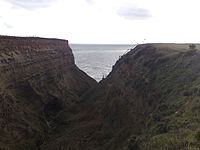Whale Chine


Whale Chine is a chine, which is to say a narrow cleft in the cliff, near Chale on the south coast of the Isle of Wight, Hampshire (part of the 'Back of the Wight'). This is one of a number of such chines on the island created by stream erosion of soft Cretaceous and Jurassic rocks.
Whale Chine is a narrow and steep coastal ravine dropping 140 feet through Lower Greensand rocks from clifftop farmland to Chale Bay. Its name probably originates from the Wavell family, owners of the nearby Atherfield Farm between 1557 and 1636.[1]
The chine is reached from a car park on the A3055 coastal road, where a stream running parallel to the cliff takes a right-angled bend to descend to the beach.[2] In the past, descent to the beach at Whale Chine could be achieved by some 126 wooden steps, since their closure in 2005, these steps were washed away by the sea in the winter storms of 2013/14. As the beach is a popular fishing site, Local fisherman have constructed a new flight of stairs by carving steps down through the rock, although this is not recommended. Despite the old steps forming part of a footpath and legal right of way, the steps are unmaintained and have been inaccessible to the public since at least 2005.
Whale Chine is a popular fishing spot for many anglers. The species caught here vary, but it is locally known as one of the best spots on the island for ray fishing: This is best from March–October. All summer species can be caught here, and it's not uncommon for shoals of mackerel and bass to drive whitebait onto the shore.
Whale Chine was the location of the wreck of the cargo ship Cormorant on 21 December 1886.[3]
Location
- Location map: 50°36’11"N, 1°20’19"W
References
- ↑ 'Finest Landscapes': The Isle of Wight Area of Outstanding Natural Beauty Partnership Newsletter, Issue 13; citing The Place-Names of the Isle of Wight, by A D Mills.
- ↑ The Jurassic isle of England, Chris Fautley, The Sunday Times, 2 July 2000
- ↑ Wreck Report for 'Cormorant', 1887, PortCities Southampton
- Island Rivers: Whale, Ladder and Walpen Chines
- Walker's guide to the Isle of Wight, Martin Collins, Norman Birch, Cicerone Press, 2000, ISBN 1-85284-221-0 Google Books, Retrieved 3 August 2008